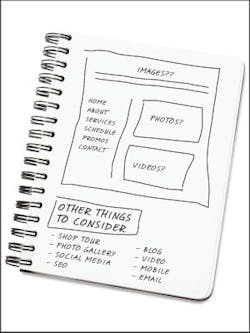More and more, customers are finding repair facilities online, and a company’s website is its first chance to interact and, hopefully, gain that customer. Building a website can be a complex task, and figuring out how to use it can be just as challenging.
Ratchet+Wrench spoke with Louis Gagnon, chief product and marking officer for Yodle, a leader in Internet marketing, which, among many other things, designs and manages websites for small businesses—including auto repair centers. Gagnon shared his thoughts on what shop owners can do to get the most out of their sites.
Small businesses, overall, have an enormous problem when it comes to their websites. From our research, about 65 percent of all small businesses have websites, and when you look at those sites, on the majority of them, it’s hard to find a phone number—if they even have it on there at all.
Most people don’t know what to put on there; they aren’t experts. The main issue most people have is that they use their website like it’s a brochure; they give generic information about their company. In this day and age, people are experts in searching online and they are looking for specific information in very specific places. Your website needs to reflect that.
Having a great website is critical. The average Yodle customer gets an average of six minutes per visitor to their site. The industry average is just 33 seconds.
It comes down to two things: What we put on the site and where we put it. Your goal with a website is to turn visitors into customers, and getting someone to read your stuff and then act upon what they read is as much a science as it is an art.
From a content standpoint, it’s very important to be concise in describing the business. The home page needs to tell customers who you are in a quick and easy-to-understand way. You need to establish the credibility up front and it needs to be driving to service pages that give the right amount of information—not too much or too little, the right amount—so that people are informed enough to pick up the phone and informed enough to make an appointment or buy a product. The phone number, the address and the details of the company have to be pervasive throughout the site.
And it all needs to be in the right places for customers to find it.
So, let’s say I come to a shop’s website. Up front, I want a good first impression that this site and this company is professional, and that it is solid and credible. You achieve that through good design.
When I come in, I have to like what I see, and I have to really quickly understand the information. It also has to be very clear that the telephone number is most important. The phone number should be what we call a “call to action,” meaning the site should be saying, “Call this company.”
On the top, right-hand side of every site, we have the telephone number on every page, and we repeat with a call to action at the bottom of every page.
So, every time I’m looking at more information, I have this call to action to pick up the phone and call this business owner.
On top of all of this, you have to take into account search engine optimization (SEO)—the different things you can do to make sure potential customers are finding your site through Internet searches.
There are two different types of SEO: on-page and off-page. The off-page aspects deal with things like Google Places and Google Maps, and making sure you have a presence on each of the main listing sites—Google, Yahoo, Yelp, MSN, all of them.
On-page SEO deals with the way you set up your website. Search engines recognize sites based on meta data and tags that you put in titles, headers, text and images on your site. On all of those, there is a small description on what this site is all about, and that’s through using keywords. You need to decide what your company is all about, and those keywords need to show up in all of those places.
And the content needs to match that. There’s a whole science that Google has developed to determine what is a credible site and what isn’t a credible site. A lot of it has to do with the amount of keywords, what you tag your website with, and how that matches your content.



